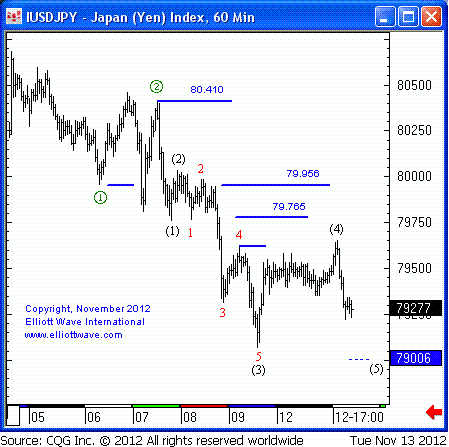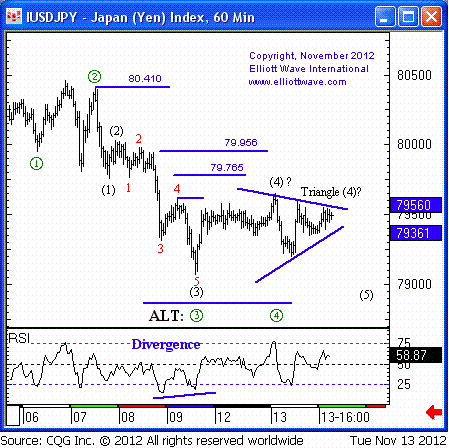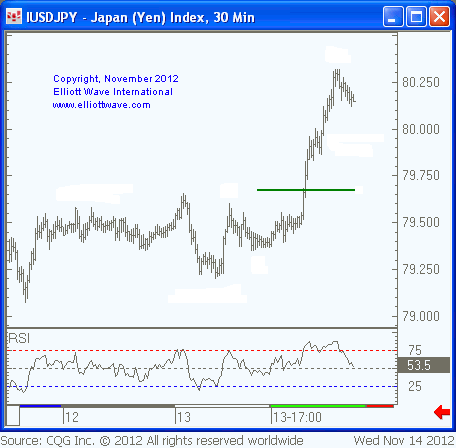Trading Forex USD/JPY With Elliott Waves
InvestorEducation / Forex Trading Nov 27, 2012 - 12:20 PM GMTBy: EWI
 Elliott wave analysis is not a crystal ball. (No market-forecasting method is.)
Elliott wave analysis is not a crystal ball. (No market-forecasting method is.)
But here's what is remarkable: Even when your Elliott wave forecast doesn't pan out, you have built-in safeguards to alert you -- and help you manage risk. Here's a real-life example.
Going into the November 14 low, USD/JPY charts had been showing an impulsive downward Elliott wave pattern. Impulses are 5-wave moves, but on November 13-14, the pattern looked incomplete: the fifth wave down seemed to be missing.
Here's a chart our Currency Specialty Service subscribers saw early on November 13:

So, our analysis on November 13 suggested that USD/JPY would fall further. But USD/JPY just would not fall; instead, it went sideways.
That suggested to our Currency Specialty Service team that the wave (4) you see in the chart above was extending. Perhaps it was developing as another Elliott wave pattern -- maybe a contracting triangle? This chart and analysis described to subscribers that scenario:

"A bearish fourth-wave triangle is another idea that's in a position to yield new lows in wave (5). Resistance rests at 79.655/765."
Note that line: "Resistance rests at 79.655/765" -- it represents the very risk-defining safeguards I mentioned earlier.
How? Well, there are things that Elliott wave patterns just are not allowed to do. In a contracting triangle (an A-B-C-D-E formation), prices must stay within converging trendlines -- and they cannot overlap the start of wave A, the origin of the pattern. Resistance at 79.655/765 was exactly that: the price point where the contracting triangle interpretation would be invalidated.
Practical application: If you were bearish on USD/JPY on November 14, you could have used the price area of 79.655/765 to manage your position risk.
As you probably know, USD/JPY did not go sideways for long. Nor did it go down. Soon after, it went higher and breached that key resistance level:

When one Elliott wave pattern ends, another one begins. As soon as that key resistance in USD/JPY was breached, a new road map for the Japanese yen became clear.
Download Your Free 14-page eBook: "Trading Forex: How the Elliott Wave Principle Can Boost Your Forex Success" Here's some of what you'll learn:
Jim also takes you through two real-world trading examples to reinforce what you've learned and apply it to your own trading. All you need is a free Club EWI profile to download this FREE 14-page eBook now >> |
This article was syndicated by Elliott Wave International and was originally published under the headline USD/JPY: Lemons into Lemonade. EWI is the world's largest market forecasting firm. Its staff of full-time analysts led by Chartered Market Technician Robert Prechter provides 24-hour-a-day market analysis to institutional and private investors around the world.
About the Publisher, Elliott Wave International
Founded in 1979 by Robert R. Prechter Jr., Elliott Wave International (EWI) is the world's largest market forecasting firm. Its staff of full-time analysts provides 24-hour-a-day market analysis to institutional and private investors around the world.
© 2005-2022 http://www.MarketOracle.co.uk - The Market Oracle is a FREE Daily Financial Markets Analysis & Forecasting online publication.




